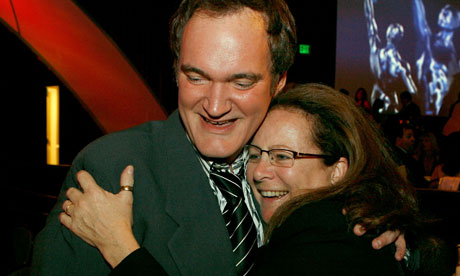Cinemas routinely charge 2-3 times normal ticket prices for the privilege of getting 3D, which is actually most often a 'retrofitting' of a 2D movie, rendered into 3D via a computer process rather than planned and shot in 3D.
Its a key issue to consider not just for your AS exam, but also your coursework!
Speaking of which, with the A2 task in mind, I wonder when we'll start getting music videos in 3D? Surely somebody has thought of this by now?! If you find the article which considers director Wim Wenders' opinion that 3D transforms dance-based movies, surely the same applies to the average performance-based music video?
The Guardian gathers together articles on 3D at: http://www.guardian.co.uk/technology/3d
Here's a good, opinionated article to get you started. The user comments are typically robust, featuring some strong language, but a goldmine too, eg this from 'Gelion':
At present putting a film out in 3D must be synonymous with the audience knowing that that film is going to be poorly rated.The article (http://www.guardian.co.uk/film/filmblog/2010/sep/29/star-wars-inception-hbo-3d):
Some weeks ago on another thread I looked at the scores for films in 3D out to date on Rotten Tomatoes.
The average score was 30% (you could argue the only one holding it up was Avatar - but take the special effects out of that film, and in my view you have very little left.)
The Last Airbender with 6% and Cats and Dogs, The Revenge of Kitty Galore 3D! at 13% were the bottom of a very bad pile.
So at the moment, 3D remains a gimmick used to entice film goers to pay their money to view poorly rated films.
It must be a haunting fact for the producers of these films that 3D might soon be common place.
Blurred vision on the 3D bandwagon
With Star Wars and Inception returning in stereoscopic vision – and three-dimensional HBO due to launch – is 2D dead?
So much prettier in 3D ... a two-dimensional Jar Jar Binks in Star Wars Episode 1: The Phantom Menace. Photograph: AFP The intriguing thing about 3D is that even after the enormous success of Avatar nobody knows yet how extensive its use will become in modern film. Might 2D eventually become the exclusive preserve of low budget or independent film-making, with virtually all mainstream fare pushed into stereoscopic vision? Or, once all the fuss and hype dies down, will we see 3D only where its use is sensible: in features with the kind of content that lends itself to the experience?
Up until recently, most observers have seen the second outcome as the more likely one. But there appears to be a rabid frenzy going on in Hollywood right now, with every project under the sun seemingly being green-lit in 3D. Today, the US trades confirmed the rumours that George Lucas is to bring his entire six-film Star Wars saga back to the big screen in stereoscopic vision, starting with 1999's The Phantom Menace (because blooming Jar Jar Binks' fizzog will naturally be infinitely less irritating in three dimensions than it was in two) in 2012. And, in a separate report, I read that Warner Bros is considering retro-fitting Christopher Nolan's Inception for a 3D re-release in cinemas and on the small screen, via US network HBO's soon-to-be-launched 3D TV channel.
Yes, that's right, 3D TVs are very much here. You can buy one now, though you may have to remortgage your house to do so. Naturally, however, as more people grab one the prices will come down. And before long you won't have to wear glasses in order to see that extra dimension: new technologies are already in place which use a different system to trick the eyes into picking up extra depth.
Whether we actually want all this extra gimmickry is a moot point, but it has to be a concern if Hollywoodinhidef.com's report is correct and a film-maker such as Nolan, who specifically chose not to make Inception a 3D project, is now being pushed into doing so retrospectively. Even worse, the article suggests that the film-maker's forthcoming sequel to the Dark Knight, the third in his excellent Batman series, will be shot in three dimensions – whether Nolan likes it or not.
Imagine that. In a few years' time, you sit down for an eight-hour Batman marathon, watching all three films back to back (I'm sad enough to have done this with Peter Jackson's Lord of the Rings, so I'm confident that this is a genuine potential scenario) and when it comes to the final movie everything suddenly goes all 3D. Or will Warner insist that the first two films are also refitted? What a bunch of jokers.
I'll add a few links here in due course, starting with this...from The Guardian. I can't recommend strongly enough that you browse/read the paper/site regularly, it is a real treasure trove.
With the market overall slipping 3% from the equivalent frame from 2009, when Slumdog Millionaire and Gran Torino led the field, cinemas are hotly anticipating the arrival of Tim Burton's Alice in Wonderland on Friday. All the big plex chains have now made their peace with Disney over the film's early DVD release date, presumably extracting more generous terms in the revenue split on box office. This means Alice will be limited only by the still insufficient number of 3D screens, where it will presumably lose the late-evening showtime to Avatar.
 A cut above ... Quentin Tarantino with editor Sally Menke in 2007. Photograph: Kevin Winter/Getty Images Sally Menke
A cut above ... Quentin Tarantino with editor Sally Menke in 2007. Photograph: Kevin Winter/Getty Images Sally Menke 